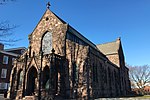The Sophia Astley Kirkpatrick Memorial Chapel, known as Kirkpatrick Chapel, is the chapel to Rutgers, The State University of New Jersey and located on the university's main campus in New Brunswick, New Jersey in the United States. Kirkpatrick Chapel is among the university's oldest extant buildings, and one of six buildings located on a historic section of the university's College Avenue Campus in New Brunswick known as the Queens Campus. Built in 1872 when Rutgers was a small, private liberal arts college, the chapel was designed by architect Henry Janeway Hardenbergh at the beginning of his career. Hardenbergh, a native of New Brunswick, was the great-great-grandson of Rutgers' first president, the Rev. Jacob Rutsen Hardenbergh. It was the third of three projects that Hardenbergh designed for the college.
Kirkpatrick Chapel was named in honour of Sophia Astley Kirkpatrick. Kirkpatrick was the wife of Littleton Kirkpatrick, a local attorney and politician who was a member of the board of trustees of Rutgers College from 1841 until his death in 1859. When Sophia Kirkpatrick died in 1871, Rutgers was named as the residuary legatee of her estate. A bequest of $61,054.57 (2013: US$1,174,079.38) from her estate funded the construction of the chapel. According to Rutgers, this marked the first time in New Jersey history that an institution became a direct heir to an estate.The chapel was designed in the High Victorian Gothic Revival style that was popular at the middle of the nineteenth century in the United States. Hardenbergh's design incorporated features common to fourteenth-century German and English Gothic churches. According to the New Jersey Historic Trust, the chapel's stained glass windows feature "some of the first opalescent and multicolored sheet glass manufactured in America." Four of the chapel's windows were created by the studios of Louis Comfort Tiffany. Kirkpatrick Chapel is a contributing property of the Queens Campus Historic District, which was added to the National Register of Historic Places on July 2, 1973.For its first 30 years, the chapel was used as a college library and for holding daily chapel services. Although Rutgers was founded as a private college affiliated with the Dutch Reformed faith, today, it is a state university and nonsectarian. The chapel is available to students, alumni, and faculty of all faiths, and a variety of services are held throughout the academic term. It is also used for university events including convocation, concerts, alumni and faculty weddings, funerals, and lectures by prominent intellectuals and world leaders.








